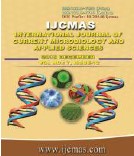


 National Academy of Agricultural Sciences (NAAS)
National Academy of Agricultural Sciences (NAAS)

|
PRINT ISSN : 2319-7692
Online ISSN : 2319-7706 Issues : 12 per year Publisher : Excellent Publishers Email : editorijcmas@gmail.com / submit@ijcmas.com Editor-in-chief: Dr.M.Prakash Index Copernicus ICV 2018: 95.39 NAAS RATING 2020: 5.38 |
The study was undertaken at Raj Mohini Devi College of Agriculture and Research Station, Ambikapur during 2017-18 for diversity of insect pollinators/ visitors in bitter gourd ecosystem. Different insect pollinators/ visitors i.e. Apis dorsata, A. indica, A. florea, xylocopa, black ant and small ants were recorded in different fluorescent colored pan trap i.e. White, yellow and blue at different flowering period onset of bloom, full bloom and end of bloom of bitter gourd. In habitat –I at the onset of bloom maximum insect pollinators/visitors were recorded in blue pan trap (7.65 insect/trap) followed by yellow pan trap (5.98 insect/trap) and minimum in white pan trap (4.31 insect/trap) however, during full bloom period highest insect pollinators/visitors were observed in yellow pan trap (27.33 insect/trap) followed by in white pan trap (20.33 insect/trap) and lowest were recorded in blue pan trap (19.33 insect/trap) and at the end of bloom higher population was recorded in yellow pan trap (14.64 insect/trap) followed by in blue pan trap (12.98 insect/trap) and lower population were recorded in white 7.65 insect/trap. In habitat-II at the onset of bloom maximum population were found in yellow pan trap (21.98 insect/trap) followed by in blue pan trap (21.65 insect/trap) and minimum population were recorded in white pan trap (15.64 insect/trap) however, at the full bloom period highest insect population were recorded in blue pan trap (21.98 insect/trap) followed by in yellow pan trap (21.31 insect/trap) and lower population were found in in white pan trap (19.31 insect/trap) and at the end of bloom highest population were recorded in blue pan trap (17.98 insect/trap) followed by in yellow pan trap (17.31 insect/trap) and lowest in white pan trap(13.32 insect/trap).
 |
 |
 |
 |
 |